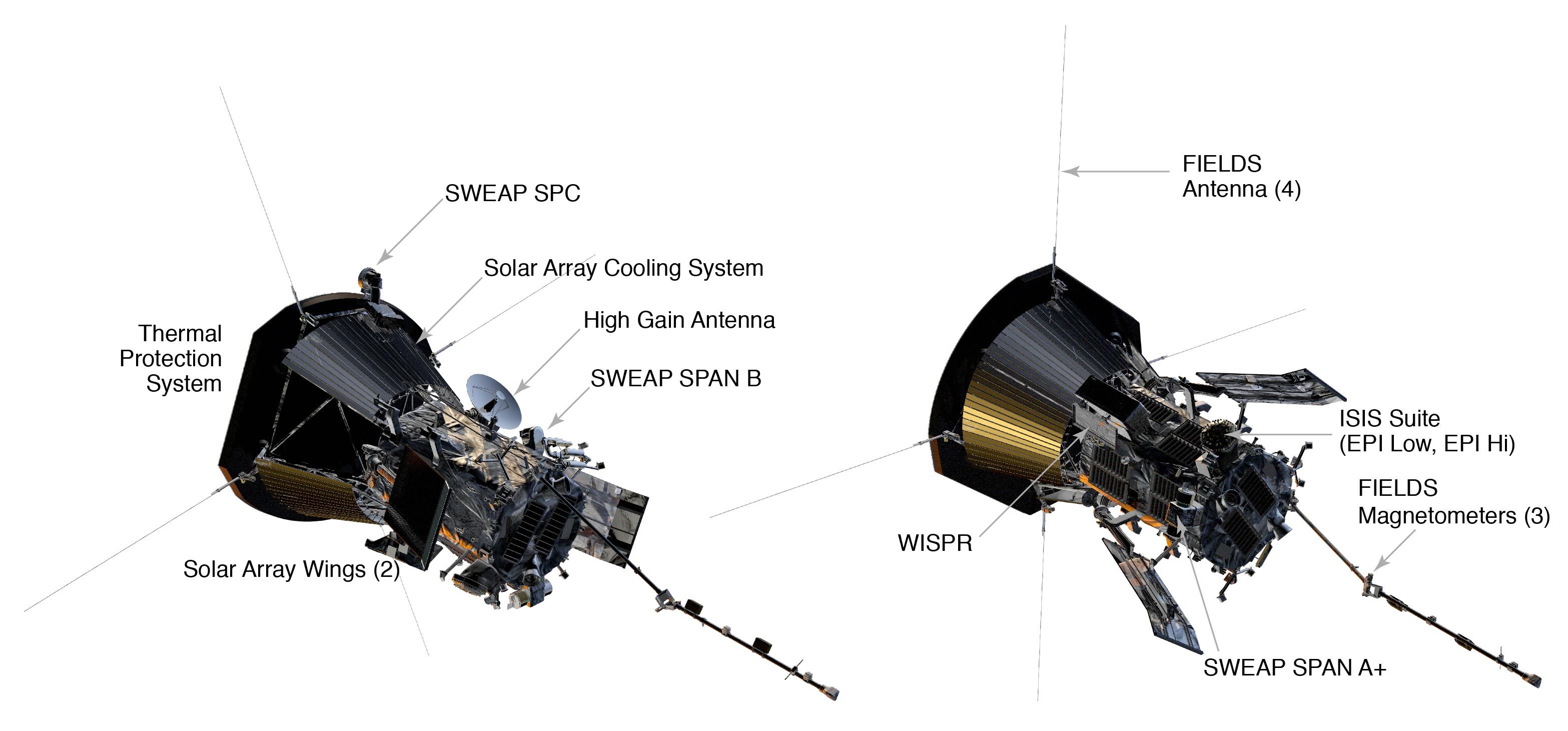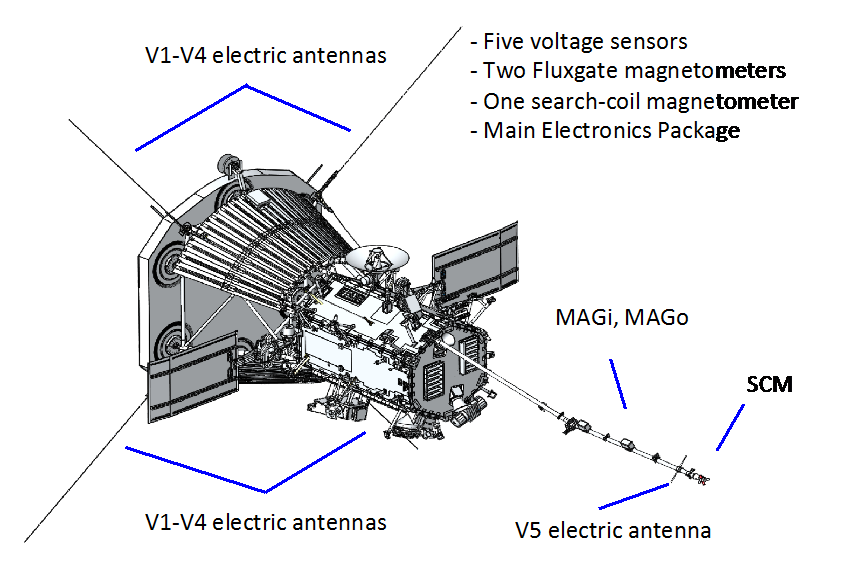What tools does the Parker sun probe have?
- Transfer

Source: The Bruce Murray Space Image Library
(Translator’s note: since in the comments to the previous article the questions “what can be observed there and how?” Were repeatedly heard, I decided to further translate the article about the tools with which Parker is equipped)
Solar Parker probe intended to work in extremely extreme conditions, it will go to the solar corona, where no spacecraft has ever been. The probe will collect data on electrical and magnetic fields and various particles with the help of four main instruments, each of which is specifically designed to withstand high temperatures and radiation.
FIELDS
(Electromagnetic Fields Investigation, the study of electromagnetic fields)

Source
FIELDS is designed to analyze what can not be seen with the naked eye - the electric and magnetic fields of the solar atmosphere, their parameters and configuration. The tool will allow detecting the occurrence of ripples and turbulence in the depth of the heliosphere with extremely high resolution, making it possible to establish the relationship between field characteristics and such phenomena as Rossby waves , head shock waves and magnetic reconnections .
The FIELDS sensors are five two-meter antennas, four of which protrude beyond the thermal shield and are exposed to temperatures of 1370 degrees Celsius, so they are made of a niobium alloy. The fifth antenna, located in the “shadow” of the apparatus perpendicular to the plane of the others, helps to construct a three-dimensional pattern of oscillations of the electric field in the high frequency range. Thanks to them, Parker can collect data both directly and over long distances. Antennas that are “in the light” operate in two different modes, distinguishing separately the “slow” and “fast” solar winds - particle streams constantly emitted by the Sun.
The magnetic fields of the FIELDS are “sensed” by three magnetometers, each approximately the size of a fist. Induction magnetometerThe SCM (Search Coil Magnetometer), the output voltage of which varies depending on the magnetic flux around, tracks the change in the field over time, and the two identical fluxgate magnetometers MAGi and MAGo are designed to estimate the magnitude of the field. MAG will be mainly used in areas of the trajectory remote from the Sun, where the field changes smoothly, and SCM, which takes readings up to two million times per second, will be needed in a low orbit.
FIELDS was developed at the Space Research Laboratory at the University of California, Berkeley (lead researcher Stuart D. Bale).
WISPR
(The Wide-Field Imager for the Parker Solar Probe, wide-angle camera) WISPR

source
or The Wide-Field Imager for the Parker Solar Probe , which is supposed to capture images of large structures formed by the solar wind and corona — Parker’s only visual observation tool. This device, about the size of a shoebox, is intended for photographing coronal emissions (coronal mass ejections or CME), jets and other effects of loss of substance by the Sun. Since the probe will sooner or later encounter these phenomena directly, collecting data using other systems, the photographs will be useful in order to understand the connection between the measured parameters and the observed picture.
To avoid direct illumination and take a picture of the crown, WISPR will be positioned behind a thermal shield, and a small amount of light that can get into the camera due to diffraction on the edge of the shield or re-reflections on other surfaces of the probe will be absorbed by special blends and screens.
As a sensing element in WISPR, two radiation-resistant CMOS arrays with active pixels are used , which are lighter and consume less energy than CCDs . In addition, such matrices are less affected by cosmic rays and other high-energy particles, which is very important near the Sun. Camera lenses are made of radiation-resistant BK7 glass used in orbital telescopes and are additionally protected from cosmic dust.
WISPR, as well as its associated program of experiments, was developed at the Division of Physics of the Sun and Heliosphere at the Naval Research Laboratory, Washington (lead researcher Russell Howard).
SWEAP
(Solar Wind Electrons Alphas and Protons investigation, the

source of
SWEAP, or Solar Wind Electrons Alphas and Protons investigation ) consists of two complementary tools, Solar Probe Cup, also known as SPC, and SPAN, also Solar Probe Analyzers . These devices make it possible to quite accurately calculate the number of particles most characteristic of the solar wind — alpha (helium nucleus), beta (electrons) and protons — and also measure their parameters, such as speed, flux density and temperature, and thus complement our knowledge of solar wind and coronary plasma.
SPC, also known as the Faraday Cylinder, is a metal trap for charged particles, installed in a vacuum, and must also withstand prolonged exposure to the Sun, as it is located beyond the edge of the heat shield. Structurally, it is a series of easily permeable grids, each of which is supplied with a high voltage of different size in order to sort the particles by type, and collector plates, which determine the characteristics of the particles falling through them. The grids will also filter out background noise that introduces an error in the measurements, like cosmic rays and photo-ionized plasma. Probably, in the process of operation, the electrodes will heat up to about 1600 degrees Celsius, therefore the grid insulators are made of sapphire. Every second, the SPC takes 146 measurements in the solar plasma to determine its density, speed, and temperature.
SPAN, in turn, is made up of two blocks, SPAN-A and SPAN-B, each of which has a fairly wide capture sector, allowing you to detect particles not seen by SPC. Each particle captured by any of the blocks falls into a kind of labyrinth of reflectors and electrodes, sorting the flow according to charge and mass. SPAN-A can work with both electrons and ions, while SPAN-B can work only with electrons.
SWEAP is mostly developed through the collaboration of the Smithsonian Astrophysical Observatory in Cambridge, Massachusetts, and the University of California, Berkeley space research laboratory (lead researcher Justin Kasper, University of Michigan).
ISʘIS
(The Integrated Science Investigation of the Sun, the integrated research system of the Sun) The

source
ISʘIS (pronounced “isis”, the circle in the middle is the astronomical symbol of the Sun) also represents two interrelated tools for the integrated study of solar particles in a wide range of energies. With the help of ISʘIS, one can study electrons, protons, ions - and find out where they came from, how they accelerated and how they got out of the Sun. The units of the system are called EPI-Lo and EPI-Hi (EPI, Energetic Particle Instrument - a tool for the study of high-energy particles).
EPI-Lo analyzes the spectrum of electrons and ions, thus allowing carbon, oxygen, neon, magnesium, silicon, iron and two helium isotopes, He-3 and He-4 to be separated - by the latter because of the characteristic difference between them. several different hypotheses about the mechanics of acceleration of particles by the sun. The device is somewhat reminiscent of a sea urchin - an octahedral dome, on which there are 80 windows, each the size of a small coin; due to this, a wide field of view is achieved. Behind each window there are two composite films (carbon- polyimide- aluminum) and a semiconductor detector in the form of a microchannel plate.. When colliding with each film, the particle knocks out electrons, which are then caught by the plate; Having determined the amount of energy obtained after the collision and the time of passage between the films, one can find out the type of particle.
EPI – Hi works with particles of more energy than EPI – Lo, and uses for this purpose three separate sensors, each of which is a set of layer-by-layer detectors. The detectors are made of ultra-thin layers of silicon and are divided into segments, which will allow both to determine the trajectory of the particle and reduce the background noise. The identification of a particle is carried out by how deep it goes through the layers and how much it ionizes each. It is assumed that EPI – Hi on the parts of the orbit closest to the Sun will be able to identify up to one hundred thousand particles per second.
Through the joint operation of these two subsystems, ISʘIS will make it possible to refine the data obtained from SWEAP.
The ISʘIS program is run by Princeton University in Princeton, New Jersey (lead researcher David McComas), and the main components of the facility are produced at the Applied Physics Laboratory. Johns Hopkins in Laurel, Maryland, and Caltech in Pasadena, California. Also a huge contribution to the creation of ISʘIS was made by the Southwestern Research Institute in San Antonio, Texas, and the NASA Center for Space Flight. Goddard in Greenbelt, Maryland. The ISʘIS data center will be located at New Hampshire University in Durham.
Heliopsp
(The Heliospheric Origins with Parker Solar Probe, the nature of the heliosphere)
No, this is not a separate device, but a program to study the nature and origin of the heliosphere, which will be conducted by the University of California, Los Angeles (lead researcher Marco Velli).
